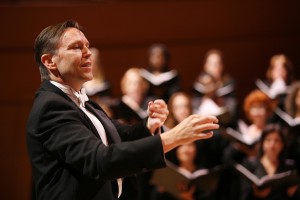Los Angeles Master Chorale highlights modern composers
Minimalism, a multi-genre artistic movement associated with the turbulent 1960s and ’70s, has made a comeback at the Los Angeles Master Chorale’s second Minimalist Jukebox Festival. Minimalism describes a calculated reduction in form or musical elements, such as rhythm, melody and harmony. The movement was a reaction against the complicated and separated art forms — it aimed to unite and democratize the arts. Minimalist compositions, much like minimalist visual art, are simple, repetitive and generally pleasing. These uncluttered compositions are spare and deceptively simple, and can be appreciated by casual listeners as well as art connoisseurs. In addition, minimalist compositions have a meditative quality yet retain the emotional impact of more elaborate pieces.

Jukebox hero · The Los Angeles Chorale presents the second annual Minimalist Jukebox Festival, which celebrated the musical movement known for rhythm, repetition and looping. – Photo courtesy of LAMC
The Los Angeles Chorale’s second Minimalist Jukebox Festival celebrates minimalism in many musical forms. John Adams, creative chair and minimalist pioneer, arranged the festival as an interdisciplinary exploration of minimalism. The monthlong event includes museum exhibitions, dance performances and concerts across Los Angeles.
The Los Angeles Master Chorale joined the celebration on Monday, April 7. The Master Chorale’s concert featured American composers Steve Reich and David Lang and opened with a pre-minimalist work attributed to Pérotin, a French composer. The program showed a breadth of minimalist works.
“Look at the ways the pieces are different and ask why we group them together … [Minimalism] has more differences than similarities,” Los Angeles Master Chorale Director Grant Gershon said.
The Los Angeles Master Chorale opened the concert with a moving rendition of Tomás Luis da Vittoria’s “Ave Maria.” The chorale dedicated this beautifully haunting song to the late Paul Salamunovich and the audience observed a moment of silent remembrance. Salamunovich, who died on Thursday, was the chorale’s music director emeritus from 1991-2001 and was an adjunct professor at USC’s Thornton School of Music.
The chorale transitioned into Sederunt principles, “The Princes Sat.” Composed around the year 1200, the composition is one of the earliest surviving precursors to minimalism. Even though the composer is difficult to pinpoint, scholars credit Pérotin with the work. The men’s choir’s only piece drew on the tradition of Gregorian chant and used text from Psalm 118. Pérotin adds sonic layers to the consistent tenor line, creating an organa quadruple, a musical arrangement for four voices. Gershon described this piece as a precursor to minimalism because “[it] takes snippets of music and creates interlocking patterns over a slowly moving harmony.”
The concert continued in a somber mood with David Lang’s “little match girl passion.” Lang’s piece draws from the Hans Christian Andersen story by the same name and alludes to Johann Sebastian Bach’s grand “St. Matthew Passion.” The Master Chorale’s 2011 performance of this piece stunned critics, but “little match girl passion” truly shines alongside other minimalist works. The story of the little match girl is interspersed with commentary choruses, allowing the audience to experience the narrative both directly and indirectly. Lang used additive repetition — building on simple, repeated melodies — and adds cold-sounding chords to portray the little match girl’s suffering.
“There are no overt musical quotes to Bach, but it shares the same characteristics — there is nothing baroque about this piece — the austerity of it is what makes it so moving,” Gershon said.
The minimalist movement centers on breaking conventions and subverting boundaries between artistic categories; thus, Lang’s “little match girl passion” is an excellent example of minimalism. Not only does it adhere to minimalistic techniques, but it also blends musical and literary forms, while demonstrating the power of simplicity. “little match girl passion” is a wrenching tale of suffering, and it reinforces the idea that art does not need to be complicated to be emotionally effective.
The concert closed with Reich’s “You Are (Variations),” each of the four movements providing a subtly different setting of the melodic theme. Reich’s piece wove four piano lines into an intricate yet spare accompaniment. This provided a rich, striking sound and matched the energy in the vocal line and percussion. Similar to the repeated musical motifs, the text was also reprised, both in English and in Hebrew. Reich’s deeply spiritual piece falls into an informal subsection of minimalism called “holy minimalism,” which became prominent in 1990. This emotionally buoyant piece provided an uplifting end to the concert.
Minimalism reaches beyond the Western canon of baroque music — Bach and Vivaldi — in favor of Eastern and contemporary musical movements. Even though this movement has a calculated, intellectual quality, it is a key component in popular music. Rock and pop bands, such as Velvet Underground and Spiritualized, were early adopters of minimalist techniques. The repetitive, hypnotic musical motifs of minimalism are most notable in Electronic Dance Music and techno.
Though it might sound like a stretch to classify dance music and dubstep DJs as minimalists, these styles of music share the same qualities as the compositions performed in the Minimalist Jukebox Festival. Unlike Baroque or orchestra-specific techniques, however, minimalism can easily be transferred and reused in different art forms. It is also reminiscent of the scientific theory Occam’s Razor, which suggests that the most succinct or elegant solution is generally the best choice. The Master Chorale’s performance supports this theory — sometimes the simplest music is the most beautiful.
Editor’s note: This post has been updated.


Not a stretch at all to see the connection between Steve Reich and EDM.